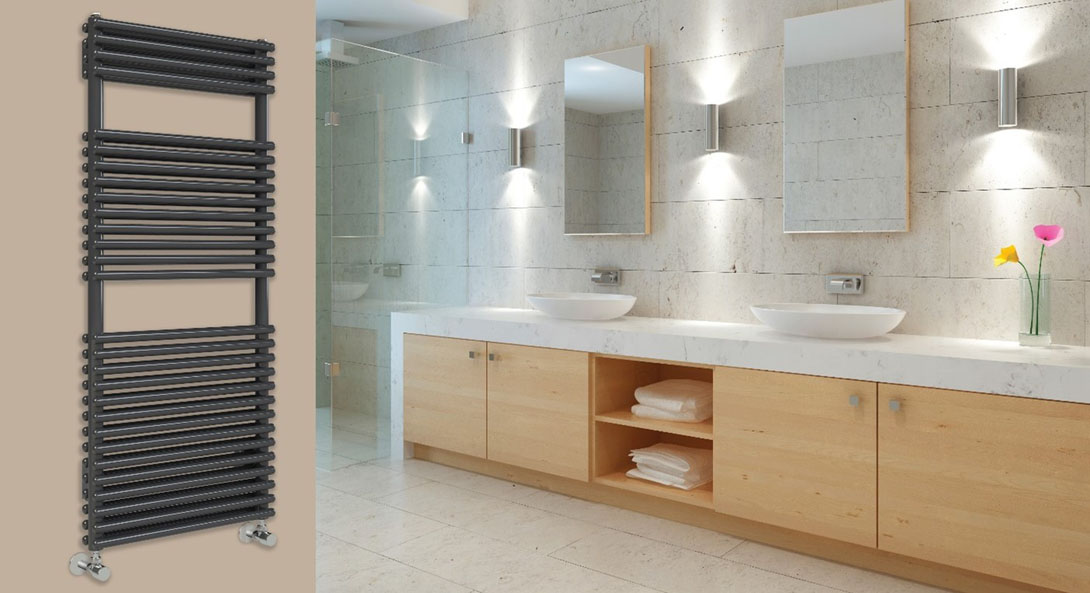News
Expert insights on choosing the best towel radiator
A towel radiator was long considered to be a luxury product. However, today it’s difficult to imagine a new bathroom being designed without one. The market has clearly evolved and so has the product offer. Hydronic, electric and even dual fuel towel radiators are now available in a wide variety of sizes, configurations and colours. But how do you choose the best towel radiator for a particular setting?

Inhouse expert Julian Stocks, Group Product Director for Radiators, offers interesting market insights and walks us through the most important factors to consider
The towel radiator market, then and now
The towel radiator market has grown significantly over the last 30 years. The product has become much more mainstream, thanks in part to its versatility as both a radiator and towel warmer, and manufacturers have invested heavily in the industrialisation and mass production of various designs for different tastes. “We see that all markets have embraced the towel radiator, mainly because it’s a practical and versatile product. But towel radiators also need to be good-looking and match the bathroom décor. They need to perform, they need to be durable, and they need to be practical. People look for all of these things. They are facilitated in this by the industrial developments that have taken place over the last couple of decades”, says Julian.
The choices available today are endless. Just think of towel radiators with weld-in vs. weld-on round tubes, flat tubes, square tubes, elliptical tubes, etc. Moreover, there is an increasing array of available colours. “We see a growing movement towards modern colours such as matt black, grey or anthracite. In the UK there has traditionally been a preference for chrome, but people are beginning to move towards painted radiators, mainly because the physical nature of the chrome product means that heat output is reduced by 30% compared to a painted radiator. There is a great deal of variety in what end users want from a towel radiator. As a major manufacturer we try to cover all those market needs and demands.”
Differences in towel radiator use
Just as design preferences tend to differ from market to market, so does the way in which a towel radiator is used. Julian explains: “In most circumstances the towel radiator is the only product in the room, so it’s used to heat the room and to dry the towels. In certain places, however, it is used as an additional product alongside a traditional radiator or underfloor heating. This means the towel radiator can be much smaller because there is another heat source already heating the bathroom.”
Hydronic vs. electric towel radiator
To provide a solution for every application, Myson includes both hydronic and electric towel radiators in their portfolio, as well as matching accessories such as hooks, handles, etc. The new Topaz double towel radiator even offers a perfect solution for low temperature heating systems.

The new double TOPAZ bathroom radiator is perfect for low temperature heating and comes in a range of attractive colours.
“The hot water market is at least 3 to 4 times bigger than the electric market and this reflects the fact that there is more boiler heating than there is electric heating. In new build homes where a boiler or heat pump is installed, they will add a hot water towel radiator. Equally, if the property is constructed with only electric heating, they will opt for an electric solution.”
Rather than choosing between a hydronic or an electric towel radiator, Julian points out that the best solution is to have a little bit of both - a product that works on hot water but also has the functionality to work independently from the central heating system, so you can use it all year round. This is possible with Myson’s dual fuel towel radiators, which work on a hot water basis when the boiler or heat pump is on during the colder months, and when the main hot water function is switched off, the electric element in the radiator provides a source of electric heat. Within this range two types of products are available: those that have a factory-fitted electric element and those that allow the installer to add an element at the point of installation.
Towel radiators & Ecodesign
In addition to market demands, the Ecodesign Directive framework is an influencing factor in the enhanced functionality of towel radiators today.
Increasing attention is given to the efficiency of the products through the accuracy of the controls. For example, the Ecodesign Directive poses that electric products need a control box with a standby as well as an inactive mode. “Having accurate controls is very important to guarantee energy efficiency.” The less accurate the controls are, the less you can control the energy consumption of the product. The EU is quite clear, if a product doesn’t meet the requirements, it simply cannot carry the CE mark. This kind of certification is important, for the protection of the consumer and for manufacturers to differentiate between higher performing products and less performing products.
Julian adds: “Going forward, the radiators’ functionality will continue to develop because people want to have more control, not just when they are at home, but also remotely. We can easily imagine the arrival of more and more smart online features in these products. At Myson, we are already jumping into the world of smart controls with our new Unisenza Plus range and the Unisenza Plus app. Behind the scenes we are also working on a solution that will open up the world of towel radiators to this possibility. The introduction of smart towel radiators with smart controls will allow users to control their radiators and towel warmer with the same application.”
The right towel radiator for the job
At the point of specification, these precise demands are of course important, but it’s even more important to ensure that the towel radiator is sized correctly. To do this the heat loss and the size of the bathroom need to be taken into account. Julian comments: “Every situation has a different set of parameters but the towel radiator needs to deliver the required heat output and to fit in the room. To provide a solution for every bathroom, small or large, we offer a wide range of sizes in our hydronic and electric towel radiators. Regardless of the situation, we have the solution and technology to fit.”
Julian also points out the importance of selecting a radiator that is fit for the environment it’s placed in. “Architects and specifiers need to ask the right questions when they are specifying the products. Special environments require special treatments. For example, if you want to use a towel warmer in a swimming pool you can, but you need to galvanise it. It is a common mistake to think that products are tested and certified and therefore will resist against anything. It is important to follow the prescriptions and to use and maintain the product as it is intended. You shouldn’t, for example, put water laden towels or wet swimming costumes on your towel radiator day after day, or clean it with a cleaning agent that contains traces of acid or alkaline. Once the radiator’s painted finish is damaged or cracked by such actions, it will start to corrode.”
There are guidelines on where best to position the towel radiator in the bathroom. Our recommendations are included in the product installation manual.
Conclusion
Like with any radiator installation, there are quite a lot of factors to consider when choosing the best towel radiator. As Julian sums it up: “It’s about picking the right product with the right looks for the right application to deliver the right performance. But also for it to be used in a way that is compatible with the original specification of the product.”
Discover our complete range of towel radiators.


